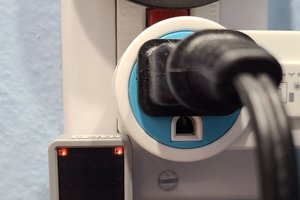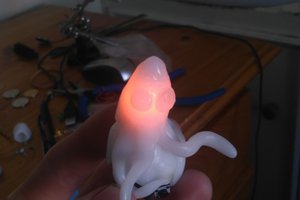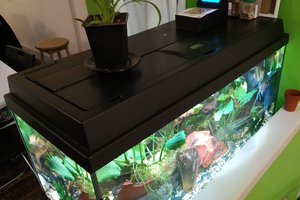Since the project is a little bit iterative, details are provided in the project logs.
Calling for hot water, the recall
Updates and expands on my earlier project with new hardware at the water heater.
Updates and expands on my earlier project with new hardware at the water heater.
To make the experience fit your profile, pick a username and tell us what interests you.
We found and based on your interests.
Since the project is a little bit iterative, details are provided in the project logs.
Besides the collaborative reverse-engineering effort documented in the forum thread, there are at least 2 concrete ESPHome interface configurations. They differ a bit in approach. The github repositories for both include documentation of the packet formats. They expect bytes to be read/written over the UART interface, implying a separate component that translates the microcontroller's logic levels to RS485 signals.
The repository https://github.com/evanjarrett/ESPHome-Navien takes the approach of defining everything inside a YAML file. Debug logging within that configuration facilitates the iterative discovery process for reverse engineering. Most of the packet data bytes are made available as simple values, but some well-understood items are given semantically meaningful names. Some ideas for this repository seem to have been taken from or inspired by https://github.com/esphome-econet/esphome-econet.
The repository https://github.com/htumanyan/navien takes the approach isolating the low-level manipulation into an ESPHome custom component. That simplifies the YAML configuration and, in the long term, is more consistent with how other components are usually referenced in ESPHome. However, it comes at the expense of being a bit more cumbersome for iterative discovery. Only a handful of data items are exposed as sensors and switches for use in YAML. Adding more requires manipulating the code for the custom component and making related changes to the YAML.
There is also a non-ESPHome implementation in repository https://github.com/dacarson/NavienManager. It used Arduino environment but is still useful as an information source.
My short-term aims are these:
Taking those into account and the current state of the two GitHub repositories, I plan to start with the pure YAML implementation. I'll observe for a while and then decide what to do.
In the forum thread I mentioned, other people have already figured out the connectors and wiring arrangement for the Navien board's RS485 interface. For example, in this post, user aruffell provides this clear picture of a custom cable they created:
The connector in the picture is a 5-pin JST-XH, though the slightly preferred connector is JST-XHB (the "B" is for "buckle", the integrated clip that keeps the connector from coming out). Both have been reported to work without issue.
In this post, user tsquared shows the wiring with the connector inserted into the socket on the Navien board:
RS485 uses differential signalling, and there is an A and a B signal line. Only 4 pins of the JST-XHB connector are used. Combining the info from the above pictures, the pin assignments are:
As I mentioned, my first step is to ignore the RS485 stuff and get the hot button mechanism working with this new hardware setup. Because I used ESPHome, things are mostly abstracted. Here are the changes I made based on testing the new assembly:
Here's the YAML so far:
# https://hackaday.io/project/202744-calling-for-hot-water-the-recall
substitutions:
node_name: hotbuttonrelay-al
RELAY: 'GPIO26'
LED: 'GPIO27'
BUTTON: 'GPIO39'
log_level: 'DEBUG'
esphome:
name: ${node_name}
on_boot:
then:
# delay to allow other boot time stuff to settle down
- delay: 5s
- script.execute: set_led_cold
esp32:
board: pico32
wifi:
ssid: !secret wifi_ssid
id: !secret wifi_ssid
password: !secret wifi_password
power_save_mode: high
fast_connect: on
manual_ip:
static_ip: !secret hotbuttonrelay-al_ip
gateway: !secret wifi_gateway
subnet: !secret wifi_subnet
dns1: !secret wifi_dns1
dns2: !secret wifi_dns2
logger:
level: ${log_level}
api:
encryption:
key: !secret hotbuttonrelay-al_apikey
reboot_timeout: 60min
services:
- service: set_led_hot
then:
- logger.log:
tag: 'hotbutton'
level: INFO
format: "service: set_led_hot"
- script.execute: set_led_hot
- service: set_led_cold
then:
- logger.log:
tag: 'hotbutton'
level: INFO
format: "service: set_led_cold"
- script.execute: set_led_cold
- service: set_led_off
then:
- logger.log:
tag: 'hotbutton'
level: INFO
format: "service: set_led_off"
- script.execute: set_led_off
ota:
platform: esphome
password: !secret ota_password
switch:
- platform: restart
name: "${node_name} Reboot"
- platform: gpio
id: i_relay
name: '${node_name} relay'
pin: '${RELAY}'
restore_mode: ALWAYS_OFF
icon: mdi:hot-tub
on_turn_on:
- light.turn_on:
id: bright_light
red: 0%
green: 100%
blue: 0%
- delay: 500ms
- switch.turn_off: i_relay
- light.turn_off:
id: bright_light
# Local test button. This goes through the relay logic,
# so it's not an analog press of the water heater button.
binary_sensor:
- platform: gpio
name: "${node_name} Button"
id: i_button
pin:
number: '${BUTTON}'
inverted: true
mode:
input: true
filters:
- delayed_on: 10ms
- delayed_off: 10ms
light:
- platform: fastled_clockless
id: bright_light
name: ${node_name} LED
chipset: SK6812
pin: '${LED}'
num_leds: 1
rgb_order: GRB # required
default_transition_length: 0s
icon: mdi:led-on
effects:
- pulse:
name: fast_pulse
transition_length: 0.25s
update_interval: 0.25s
min_brightness: 20%
max_brightness: 99%
script:
- id: set_led_hot
then:
- delay: 600ms # give the relay blink a chance to show
- light.turn_on:
id: bright_light
red: 100%
green: 60%
blue: 0%
effect: fast_pulse
- id: set_led_cold
then:
...
Read more »
The RS485 unit and the relay unit both have LEGO-compatible holes in their bodies. I decided to make a 3D-printed slab with a few LEGO studs in the right places to take advantage of that. I started with this nice custom LEGO component generating script: https://github.com/cfinke/LEGO.scad. My requirement was a little unusual, so I made a couple of local modifications to that OpenSCAD script.
The script does include a parametric scaling factor for the diameter size of the studs. Through trial and error, I settled on 1.01 (ie, 101%) to allow for filament shrinkage and still have a snug fit.
Here are the bottom sides of the components along with the 6x6 base I created.
And here is what it looks like when it's press-fit together:
I think it makes a pretty tidy bundle. I haven't yet decided how I will mount this bundle to the water heater, but I'll probably use the refrigerator magnet technology I tried before. This bundle is a bit lighter than the bundle from the earlier project.
At the water heater end, requirements are minimal. Just about any ESP32 variant would fit the bill. I decided to use something from their Atom series since they are cheap and I already have some on hand. Specifically, I'll use an Atom Lite, which has two physical buttons and a single RGB LED.
They have a couple different RS485 interface components that will work with the Atom series. The cheapest option is their RS485 to TTL Converter Unit.
For a tiny amount more, their ATOM Tail485 - RS485 Converter for ATOM makes for a tidier package since it plugs directly into the Atom Lite.
In the end, I didn't choose either of those. I spent a few bucks more and chose the ATOMIC RS485 Base.
The reason for that choice is because it leaves the 4-pin port on the Atom Lite exposed. (It also leaves the USB-C port exposed for power, though once it's wired up to an RS485 circuit, that circuit can power everything.) I'm not sure if the reverse-engineered RS485 conversation will let me remotely "push the button" to call for hot water. For insurance, my first step will be to implement the hot button feature using a relay, as in the previous project. This Mini 3A Relay Unit interfaces to the Atom Lite via that 4-pin port.
The total cost for these three components is under US$20, which is not too bad for a one-off project.
My original project has been operating for a while in a satisfactory way. I do still have one unsolved problem (knowing when the pump stops pumping), though for a while I've had some ideas about how to tackle that. In the meanwhile, some clever and industrious people over in the Home Assistant forums have been making progress on reverse engineering the wire protocol between Navien's NaviLink unit and the tankless water heater. I think that will give me the answer about the pump (not sure). To find out, I'll need an RS485 interface to the water heater control board.
If you look around for an RS485 interface board (as some of the folks in that forum thread have done), you come across some components from M5stack. Their stuff is particularly appealing for one-off projects since it mostly comes in reasonably attractive packages. I already have a little box full of assorted M5stack stuff, so I decided to make use of that and a few things I had to order from them to re-implement the hardware.
Create an account to leave a comment. Already have an account? Log In.
Become a member to follow this project and never miss any updates

 Timber Rough
Timber Rough
 WJCarpenter
WJCarpenter
 johnowhitaker
johnowhitaker
 Owen
Owen